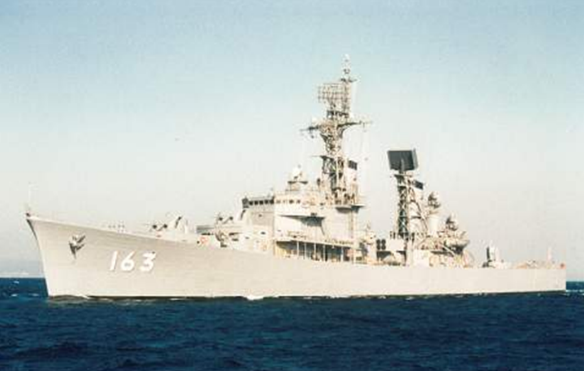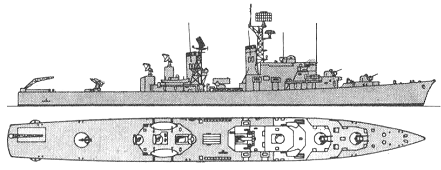
Development & Context
DG 163 was the first Japanese missile destroyer. Due to its limited size, no Terrier or Talos systems were implemented, but rather the light Tartar, and later Standard missile system (which derived from the Tartar). This was also later completed by a RUR-5 ASROC system with Mk.112 octuple launcher (post 1967) which proved in the future far more versatile. This combination was quite unique, and the size of the ship was adapted to it by almost double the displacement of the 1950s destroyers generation. So emphasis was still put on AAW/ASW capabilities, and from there, the JMSDF would alternate between AAW destroyers, ASW escorts (smaller) and large ASW destroyers (helicopter DDs). Proper ASuW capabilities (anti-ship) arrived from the Hatsusuki class (1980) first with harpoon missiles.
DDG 163 Amatsukaze was built at Mitsubishi shipyards in Nagazaki. She was laid down on 29.11.1962, launched 5.10.1963 and completed on 15.02.1965, and modernized just two years afterwards. After a career without notable incident, she was discarded in 1995 and latter scrapped. Her anchor and propeller had been preserved.
⚠ Note: This post is in writing. Completion expected in late 2023.
❯❯❯❯❯❯❯❯❯❯❯
Design
Amatsukaze was planned as the DDG variant of the Akizuki class, basically a traditional gun-armed anti-aircraft destroyer. She had both at first the missile control system of the Tartar system. but since the latter proved to be larger than expected, her design was completely modified notably with an extended hull, and shelter cover design based on the Isuzu class. She also had improved steam turbines and the RIM-24B Improved Tartar was replaced by the SM-1.
This meant for this class, the classic 127 mm (5 in) artillery was omitted for good and traditional 21-in TTs, two Mk.2 over-the-side launchers later replaced by lateral, smaller triple banks Mk32 firing acoustic ASW torpedoes. The electronic suite was also quite extensive and brand new, supported by lattice masts. The bridge superstructure was also larger and squarish and the hull flush deck (no more forecastle). The two twin 3-in mounts were forward, “B” superfiring, the two TT banks either sides of it, the ASROC in between the two superstructures islands, and the Standard SM-1 occupying all the rear section, including the two guiding missile control systems allowing to track and follow two missiles to their targets. Many publications thought because of her clean appearance and roomy after section she was capable of housing an helicopter but she only had an helipad. Both the Mk32 and SPS-52 were additions resulting from her 1967 modernization.
Hull and general arrangements
Powerplant
Armament
Electronics
Major Reconstruction
The electronics suite was also modified heavily, following the armament and a spiral type improvement over the years. Initially, there was a 3D radar AN/SPS-39, later replaced by the AN/SPS-52,
a GFCS Mk.63 mod.14, later replaced by an FCS-2-21D, a Sonar (passive search) AN/SQS-4 later replaced by the AN/SPS-52 and active sonar AN/SQR-8 later replaced by the AN/SQS-23. Its EW suite comprised the NOLR-1B (intercept) radar, replaced in the 1980s by a combination of NOLR-6B radar (intercept), OLR-9B missile warning system and OLT-3 jammer. Because of this, the ship stayed relevant until the mid-1990s.

Amatsukaze, 2 views (src navypedia)
Specs
Displacement: 3050 tonnes standard, 4000 tonnes FL
Dimensions: 131 x 13.4 x 4.2 m
Machinery: 2 shafts Ishikawajima/GE geared turbines, 2 Ishikawajima/Foster-Wheeler boilers, 60,000 bhp. 33 knots, range 7000 nm
Sensors: Radars OPS-17, SPS-29, SPS-52, SPG-51, SPG-34, Sonar SQS-34, SQS-23
Armament: Mk13 launcher standard SAM (10 MR-1), 4x 3in/50 AA (2×2), 1×8 ASROC, 2 hedgehogs, 2 y-guns, 2×3 324mm Mk32 ASW TTs
Crew: 290
Read More/Src
Amatukaze in service
(To come)


 Latest Facebook Entry -
Latest Facebook Entry -  X(Tweeter) Naval Encyclopedia's deck archive
X(Tweeter) Naval Encyclopedia's deck archive Instagram (@navalencyc)
Instagram (@navalencyc)





 French Navy
French Navy Royal Navy
Royal Navy Russian Navy
Russian Navy Armada Espanola
Armada Espanola Austrian Navy
Austrian Navy K.u.K. Kriegsmarine
K.u.K. Kriegsmarine Dansk Marine
Dansk Marine Nautiko Hellenon
Nautiko Hellenon Koninklije Marine 1870
Koninklije Marine 1870 Marinha do Brasil
Marinha do Brasil Osmanlı Donanması
Osmanlı Donanması Marina Do Peru
Marina Do Peru Marinha do Portugal
Marinha do Portugal Regia Marina 1870
Regia Marina 1870 Nihhon Kaigun 1870
Nihhon Kaigun 1870 Preußische Marine 1870
Preußische Marine 1870 Russkiy Flot 1870
Russkiy Flot 1870 Svenska marinen
Svenska marinen Søværnet
Søværnet Union Navy
Union Navy Confederate Navy
Confederate Navy Armada de Argentina
Armada de Argentina Imperial Chinese Navy
Imperial Chinese Navy Marinha do Portugal
Marinha do Portugal Mexico
Mexico Kaiserliche Marine
Kaiserliche Marine 1898 US Navy
1898 US Navy Sovietskiy Flot
Sovietskiy Flot Royal Canadian Navy
Royal Canadian Navy Royal Australian Navy
Royal Australian Navy RNZN Fleet
RNZN Fleet Chinese Navy 1937
Chinese Navy 1937 Kriegsmarine
Kriegsmarine Chilean Navy
Chilean Navy Danish Navy
Danish Navy Finnish Navy
Finnish Navy Hellenic Navy
Hellenic Navy Polish Navy
Polish Navy Romanian Navy
Romanian Navy Turkish Navy
Turkish Navy Royal Yugoslav Navy
Royal Yugoslav Navy Royal Thai Navy
Royal Thai Navy Minor Navies
Minor Navies Albania
Albania Austria
Austria Belgium
Belgium Columbia
Columbia Costa Rica
Costa Rica Cuba
Cuba Czechoslovakia
Czechoslovakia Dominican Republic
Dominican Republic Haiti
Haiti Hungary
Hungary Honduras
Honduras Estonia
Estonia Iceland
Iceland Eire
Eire Equador
Equador Iran
Iran Iraq
Iraq Latvia
Latvia Liberia
Liberia Lithuania
Lithuania Mandchukuo
Mandchukuo Morocco
Morocco Nicaragua
Nicaragua Persia
Persia San Salvador
San Salvador Sarawak
Sarawak Uruguay
Uruguay Venezuela
Venezuela Zanzibar
Zanzibar Warsaw Pact Navies
Warsaw Pact Navies Bulgaria
Bulgaria Hungary
Hungary

 Bundesmarine
Bundesmarine Dutch Navy
Dutch Navy Hellenic Navy
Hellenic Navy Marina Militare
Marina Militare Yugoslav Navy
Yugoslav Navy Chinese Navy
Chinese Navy Indian Navy
Indian Navy Indonesian Navy
Indonesian Navy JMSDF
JMSDF North Korean Navy
North Korean Navy Pakistani Navy
Pakistani Navy Philippines Navy
Philippines Navy ROKN
ROKN Rep. of Singapore Navy
Rep. of Singapore Navy Taiwanese Navy
Taiwanese Navy IDF Navy
IDF Navy Saudi Navy
Saudi Navy Royal New Zealand Navy
Royal New Zealand Navy Egyptian Navy
Egyptian Navy South African Navy
South African Navy






























 Ukrainian Navy
Ukrainian Navy dbodesign
dbodesign